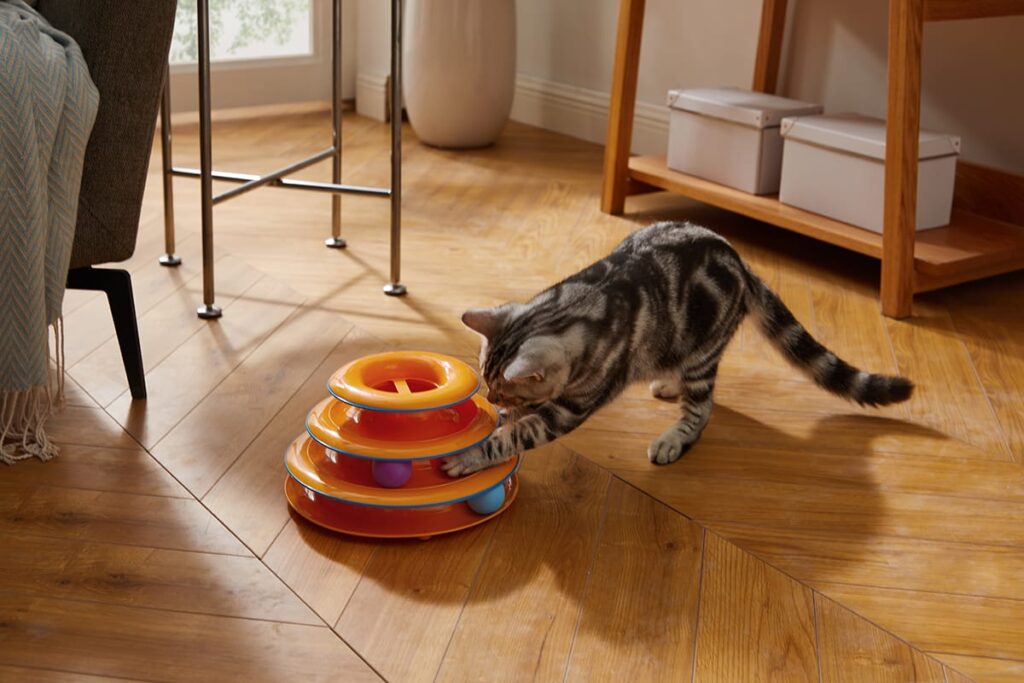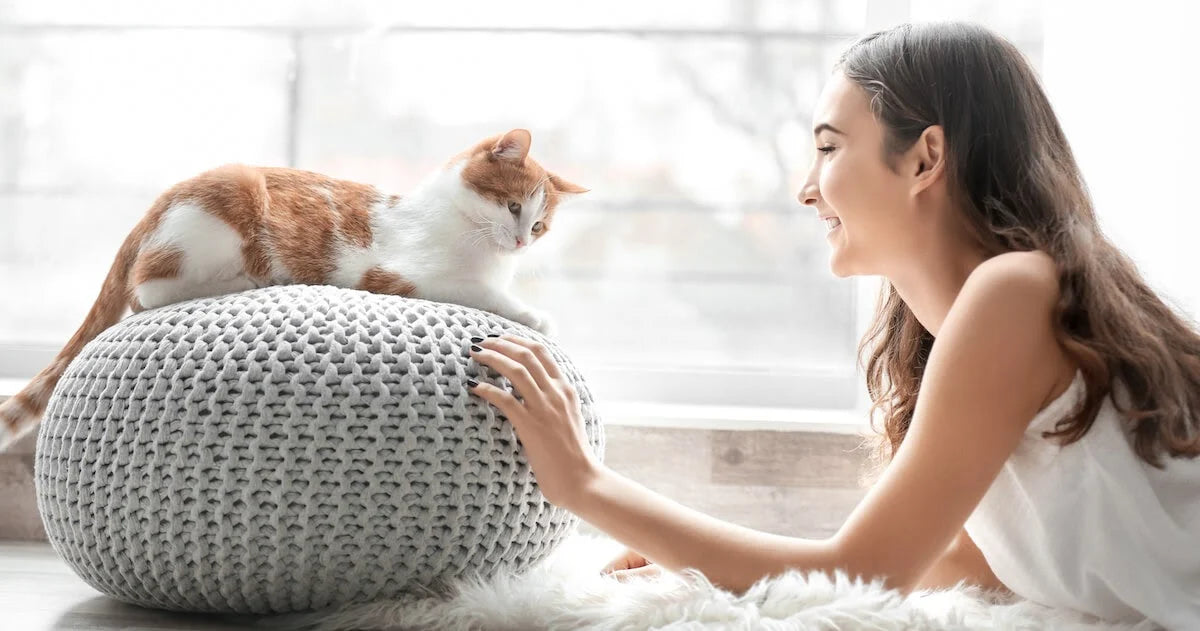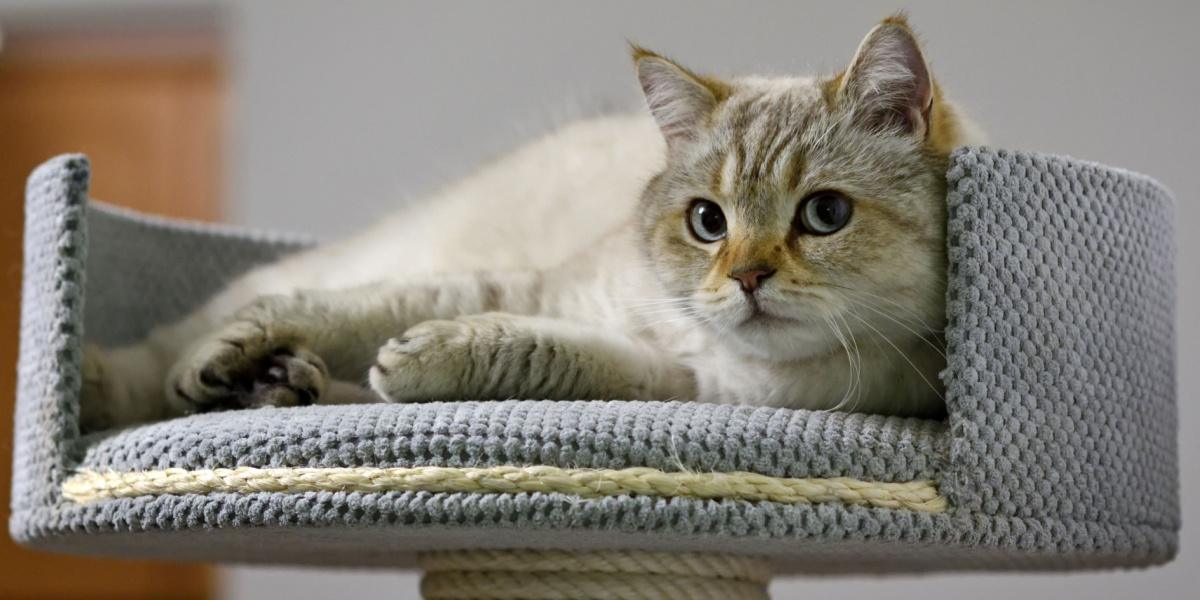The Pet Parlour Blog
Tips, Stories and Expert Advice for Pet Lovers
Mental Stimulation & Enrichment
Cats are intelligent and need daily enrichment to avoid stress.
- Rotating toys weekly to keep interest fresh
- Puzzle feeders or treat-dispensing toys to simulate hunting behavior
- Window perches or cat TV videos for safe "bird-watching"
- Vertical spaces like shelves or climbing trees for exploration


Emotional Bonding & Social Needs
Even independent cats need emotional care and interaction.
- Daily playtime sessions (10–15 minutes) to mimic prey-chase interaction
- Speaking softly or using consistent voice tones to build trust
- Allowing space and respecting boundaries to avoid overstimulation
- Using pheromone diffusers (like Feliway) to reduce stress and promote calm
Territory & Safe Spaces
Cats feel secure with consistent territory and safe zones.
- Providing hideaways or “safe zones” where the cat won’t be disturbed
- Keeping litter boxes in quiet, accessible, and private areas (one per cat + 1 rule)
- Minimizing loud noises, sudden furniture changes, or scent disruptions
- Allowing vertical ownership—like wall shelves or window hammocks

5 Proven Ways to Enrich Your Indoor Cat's Mental Wellbeing
📅 Published on: [Insert Date]
✍️ By: My Pet Parlour Team
📁 Category: Cat Care | Enrichment
Indoor cats enjoy a safe and controlled environment, but without regular mental engagement, they may experience boredom, anxiety, or behavioral issues. Cognitive stimulation is essential to your cat’s overall wellbeing—it promotes problem-solving skills, reduces stress, and strengthens your bond.
Here are five expert-recommended methods to help keep your cat mentally sharp, curious, and content inside your home.
1. Use Food-Based Enrichment Tools
Recommended Practices:
- Incorporate puzzle bowls or slow feeders during meal times.
- Freeze tuna water or broth into ice cube molds for treat time.
Why It Matters: Encourages focus and foraging instincts while preventing overfeeding.
2. Schedule Interactive Play Sessions
Recommended Practices:
- Allocate 10–15 minutes twice daily for play using wand toys or laser pointers.
- End each session with a “catch” to complete the hunting cycle.
Why It Matters: Helps reduce destructive behavior and builds trust through structured interaction.
3. Engage the Senses with Environmental Stimuli
Recommended Practices:
- Rotate between cat-safe herbs such as silvervine or valerian.
- Play curated cat entertainment videos featuring birds or fish.
- Open screened windows to allow fresh air and natural sounds.
Why It Matters: Supports alertness, curiosity, and stress reduction.
4. Provide Vertical & Private Territory
Recommended Practices:
- Install cat trees, climbing shelves, or window perches.
- Offer hideaways like covered beds or cardboard boxes.
Why It Matters: Enhances confidence, provides security, and reduces territorial conflict in multi-cat homes.
5. Rotate Toys & Introduce Novelty
Recommended Practices:
- Keep a toy rotation box and cycle in a few items weekly.
- Include different textures, shapes, and sounds in your selection.
Why It Matters: Stimulates curiosity and prevents repetitive boredom.
Bonus Tip: Try Basic Clicker Training
Training your cat using a clicker and treats can teach them commands such as “sit,” “high five,” or “come.” It’s a rewarding way to boost their mental activity and deepen your connection.
Closing Thoughts
Mental enrichment is a crucial component of feline wellness. By integrating these strategies into your daily routine, you’ll help your cat stay engaged, happy, and behaviorally balanced in an indoor environment.
Need personalized product recommendations or enrichment setup advice? Our team at My Pet Parlour is here to help. Contact us or explore our curated collection of enrichment tools designed specifically for indoor cats.
How to Build a Loving Bond with Your Cat
📅 Published on: [Insert Date]
✍️ By: My Pet Parlour Team
📁 Category: Cat Care | Emotional Wellness
While cats are often portrayed as independent and mysterious, they thrive in environments where they feel emotionally secure and connected to their human companions. Building a bond with your cat is not only heartwarming, but it also promotes better behavior, reduces stress, and enhances overall health.
1. Commit to Daily Playtime
Recommended Practices:
- Engage your cat in at least two 10–15 minute play sessions each day using interactive toys.
- Use wand toys, feather chasers, or electronic mice to mimic prey movements.
Why It Matters: Builds trust through positive interaction and satisfies hunting instincts.
2. Use Gentle Communication
Recommended Practices:
- Speak in calm, steady tones your cat will associate with safety.
- Use your cat’s name consistently when offering affection or treats.
Why It Matters: Reinforces positive association with your presence and voice.
3. Respect Personal Space & Body Language
Recommended Practices:
- Observe tail, ear, and eye movement to gauge mood and overstimulation.
- Let your cat approach you for cuddles rather than forcing interaction.
Why It Matters: Honors boundaries and creates a safe emotional dynamic.
4. Provide Comfort with Familiar Scents
Recommended Practices:
- Use soft bedding that carries your scent near resting areas.
- Diffuse feline pheromones like Feliway in high-stress rooms.
Why It Matters: Eases anxiety and reinforces a calm, loving home environment.
5. Develop Rituals & Routines
Recommended Practices:
- Maintain consistent feeding, grooming, and cuddle times.
- Use cues like treat jars or toy boxes to build predictable joy.
Why It Matters: Creates reliability that nurtures emotional stability.
Bonus Tip: Practice Slow Blinks
When your cat is calm, try giving them a slow blink (soft gaze and gradually close your eyes). If they blink back, it’s a sign of trust and affection. This small gesture can deepen your bond over time.
Closing Thoughts
Emotional bonding with your cat doesn’t require grand gestures—it’s built through everyday love, patience, and consistency. Whether through play, calm communication, or simply being present, your care builds a foundation for a lifelong, stress-free friendship.
Looking for bonding tools or calming aids? Explore our recommended calming sprays, pheromone diffusers, and interactive toys in the My Pet Parlour store today.
📝 Why Your Cat Needs Its Own Space—And How to Create It at Home
📅 Published on: [Insert Date]
✍️ By: My Pet Parlour Team
📁 Category: Cat Behavior | Indoor Living
Introduction
Cats may share our homes, but they are not pack animals like dogs. Instead, cats are highly territorial and instinctively driven to seek out areas where they can feel secure, undisturbed, and in control. Whether you live in a studio apartment or a multi-bedroom home, giving your cat their own space is not a luxury—it’s essential to their mental health, behavior, and overall well-being.
In this article, we’ll explore why your cat needs a personal retreat and provide practical, stylish ideas for setting one up in any home.
Why Personal Space Is So Important for Cats
It Reduces Stress and Anxiety
A private, quiet space helps your cat feel safe. Without a designated retreat, your cat may become easily overwhelmed by household noise, guests, children, or even other pets.
Signs of stress from lack of space include:
- Excessive hiding or aggression
- Over-grooming or changes in appetite
- Litter box issues
A well-defined space provides comfort and control, making your cat feel less vulnerable.
It Reinforces Their Natural Instincts
In the wild, cats stake out territory to hunt, rest, and observe without interference. Giving your cat a “territory” in your home taps into this instinct and makes them feel confident in their environment.
It Improves Relationships in Multi-Cat or Busy Households
If you have multiple cats, dogs, or children, shared living areas can feel competitive or stressful. By offering private, personalized areas for each cat, you reduce the chance of behavioral conflict and overstimulation.
How to Create the Perfect Cat Retreat at Home
Choose the Right Location
Look for a low-traffic, quiet part of your home. This could be:
- A spare room or corner in your bedroom
- A nook under the stairs
- A sunny window seat
- A sectioned-off area of a home office or laundry room
Avoid high-traffic spots like the kitchen or main hallway.
Use Enclosed or Semi-Enclosed Furniture
Cats love enclosed spaces that feel like caves or dens. Try:
- A cat cave bed or hooded bed
- Covered cat trees or enclosed towers
- A repurposed cabinet or shelf with a cushion inside
- Bonus Tip: Use a cardboard box with a soft blanket inside as a simple, low-cost solution.
Incorporate Vertical Territory
- Wall-mounted cat shelves
- Tall cat trees with multiple levels
- A bookshelf with a cozy bed on the top shelf
Provide Comfort and Familiar Scents
Line your cat’s space with soft, warm materials like fleece or faux fur. Add items that smell like you—such as an old t-shirt—or use pheromone diffusers like Feliway to promote calm.
Make It Enrichment-Friendly
Your cat’s space should also stimulate their mind. Include:
- A scratching post
- Puzzle toys or small stuffed prey
- A window perch with a view of the outdoors
- Cat-safe plants like wheatgrass or catnip
Respect Their Privacy
Once you create this space, allow your cat to use it on their own terms. Don’t reach in and pull them out, especially when they’re resting or hiding. This space should always be a “no-stress zone.”
Keep It Clean and Consistent
Vacuum the space weekly, wash bedding regularly, and check for any soiled or worn items. A clean retreat enhances comfort and prevents unpleasant odors.
What If You Have a Small Apartment?
Even in small homes, creative solutions work:
- Transform a shelf or closet corner into a cat nook
- Use a bench with hidden storage as a dual-purpose cat bed
- Install a hammock or platform beneath a window
The goal is not to dedicate an entire room—but to give your cat a predictable, peaceful corner they can rely on.
Final Thoughts
Providing a dedicated space for your cat isn't just a trend—it's a cornerstone of feline wellness. It honors your cat’s instincts, supports emotional stability, and leads to a calmer, happier companion. Whether you invest in designer furniture or build a simple nook with what you have, your cat will benefit from having a place that is entirely their own.
Need help creating a personalized cat retreat? My Pet Parlour offers a range of enrichment tools, cozy beds, and behavior-safe accessories to make your home feel just right for your feline companion.
Explore our shop or reach out to our feline care experts for tailored recommendations today.
General Strategy for Caring for Dogs and Cats
Taking care of pets requires attention to their physical, emotional, and social needs. Below are key strategies for providing the best care for both dogs and cats.
Proper Nutrition Is Essential
Both dogs and cats require species-appropriate diets to thrive. Their nutritional needs differ significantly:
Dogs (Omnivores):
- Require balanced proteins, carbohydrates, fats, vitamins, and minerals
- Feeding amounts based on size, age, and activity level
- Typically fed 1-2 times daily for adults
- Fresh water should always be available
Cats (Obligate Carnivores):
- Require high protein diets with specific amino acids like taurine
- Cannot process plant proteins as efficiently as animal proteins
- Generally prefer multiple small meals throughout the day
- May prefer running water sources
Quality commercial pet foods labeled as "complete and balanced" meet AAFCO standards for nutritional adequacy. Age-specific formulations (puppy/kitten, adult, senior) provide appropriate nutrition for different life stages.
Preventative Care Is Crucial
Regular veterinary care helps prevent illness and detect health problems early.
Routine Healthcare:
- Vaccinations: Core vaccines for dogs include rabies, distemper, parvovirus, and adenovirus. For cats: rabies, panleukopenia, calicivirus, and rhinotracheitis.
- Parasite Prevention: Year-round flea, tick, and heartworm prevention is recommended for both species.
- Dental Care: Regular brushing and professional cleanings help prevent periodontal disease.
- Spaying/Neutering: Reduces behavioral issues and prevents certain health problems and unwanted litters.
Vet Visit Schedule:
- Puppies/kittens: Every 3-4 weeks until 16 weeks for vaccinations
- Adult pets: Annual wellness exams
- Senior pets (7+ years): Biannual check-ups
Microchipping provides permanent identification if your pet becomes lost. Keep records of vaccinations, medications, and health history in an accessible location.
Physical & Mental Exercise Requirements
Both dogs and cats need regular exercise and mental stimulation to maintain health and prevent behavioral problems.
Dogs:
- Exercise needs vary by breed, age, and health status (30 minutes to 2+ hours daily)
- Activities include walking, hiking, playing fetch, swimming, and agility training
- Mental stimulation through puzzle toys, training sessions, and nose work
- Socialization with other dogs can provide both physical and mental benefits
Cats:
- Naturally active in short bursts throughout the day and night
- Indoor cats need environmental enrichment (cat trees, window perches, scratching posts)
- Interactive play with wand toys, laser pointers (with caution), and puzzle feeders
- Some cats enjoy leashed walks or enclosed outdoor spaces ("catios")
Regular exercise helps prevent obesity, which affects nearly 60% of pets and can lead to diabetes, joint problems, and reduced lifespan. Exercise routines should be adjusted based on age, with gentler activities for senior pets.
Maintaining Cleanliness and Comfort
Regular grooming keeps pets comfortable, healthy, and strengthens your bond.
Dogs:
- Brushing: Frequency depends on coat type (daily for long-haired breeds, weekly for short hair)
- Bathing: Every 1-3 months or when dirty, using dog-specific shampoo
- Nail trimming: Every 3-4 weeks when you hear clicking on hard floors
- Ear cleaning: Check weekly, clean as needed with veterinary-approved solution
- Tooth brushing: Ideally daily, using dog-specific toothpaste
Cats:
- Brushing: Short-haired cats benefit from weekly brushing; long-haired cats need daily attention
- Bathing: Rarely needed unless the cat gets into something sticky or dangerous
- Nail trimming: Every 2-3 weeks to prevent overgrowth and furniture damage
- Ear checks: Monthly for signs of mites, infection, or excessive wax
- Dental care: Daily brushing with cat-specific toothpaste or dental treats
Professional grooming services can be helpful for breeds with complex coat requirements or for tasks like anal gland expression. Grooming sessions are also an excellent opportunity to check for lumps, bumps, parasites, or skin issues.
Positive Reinforcement Works Best
Training and socialization are essential for well-adjusted pets and harmonious households.
Dogs:
- Basic commands (sit, stay, come, leave it) for safety and control
- Leash training to prevent pulling and ensure enjoyable walks
- Crate training provides a safe space and aids in housebreaking
- Socialization with various people, animals, and environments before 16 weeks is crucial
- Consistency in rules and expectations from all family members
Cats:
- Litter box training (most kittens learn naturally from their mothers)
- Scratching post training to protect furniture
- Handling exercises to acclimate them to grooming and vet visits
- Clicker training can teach basic behaviors and tricks
- Environmental modification to prevent unwanted behaviors
For challenging behaviors, consult with a certified animal behaviorist or trainer who uses force-free methods. Early intervention prevents the reinforcement of problem behaviors. Remember that behavior changes can sometimes indicate medical issues that should be ruled out by a veterinarian.
Creating a Pet-Safe Home
A comfortable, safe environment is essential for pets' wellbeing and prevents accidents.
General Safety:
- Remove or secure toxic plants (lilies, sago palms, azaleas, etc.)
- Store chemicals, medications, and cleaning supplies in inaccessible areas
- Secure trash cans to prevent access to harmful foods or objects
- Cover electrical cords or use pet-safe cord covers
- Remove small objects that could be swallowed
- Ensure window screens are secure, especially for cats
Comfort Essentials:
- Dogs: Comfortable bed, crate (if crate trained), food/water stations, toys
- Cats: Litter boxes (general rule: number of cats + 1), scratching posts, climbing structures, hiding spots
- Quiet spaces for retreat during stressful situations
- Temperature control (65-75°F is comfortable for most pets)
Regular inspection of toys for damage prevents choking hazards. For multi-pet households, ensure each animal has access to resources without competition. Consider pet gates or separate feeding areas to prevent conflicts between dogs and cats.



